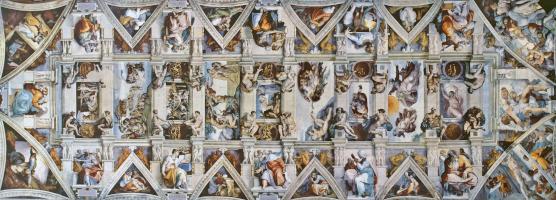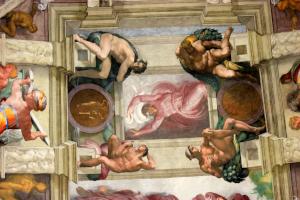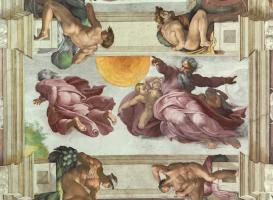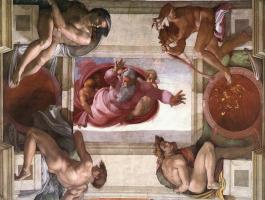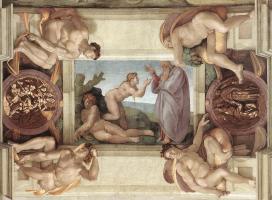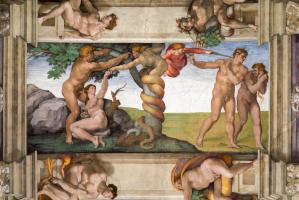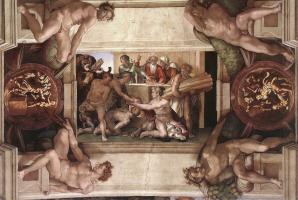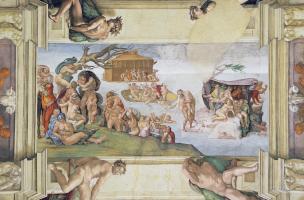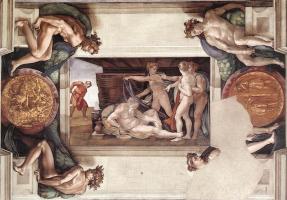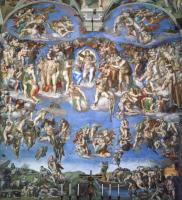Michelangelo
The phenomenal genius of Michelangelo has been praised consistently since the start of his unparalleled career. He worked for princes and popes and was pre-eminent in the High Renaissance as an architect, a sculptor and a painter. More than anyone else, he raised the crafts of painting and sculpture to the status of Fine Arts.
He was first apprenticed in the Florentine workshop of Domenico Ghirlandaio, and shortly afterwards transferred to a school set up under the patronage of Lorenzo de’ Medici, who was known as Il Magnifico. After the death of Lorenzo, Michelangelo went to Bologna and then to Rome, where he first made his name with his Pieta (a sculpture of the Virgin with the body of Christ after the descent from the cross) in St Peter’s Cathedral. The Medici of Florence and the Popes of Rome — Julius II, Leo X, Paul III — were his patrons, and he produced work for them that won him public acclaim and adulation. Vasari tells us simply that the work of Michelangelo ‘transcends and eclipses that of every other artist, living or dead… supreme not in one art alone but in all three…’ Probably his greatest achievement, which can be seen in both sculptures and paintings, was his extraordinary ability to express all the human emotions through the beauty of the naked body.
The Sistine Chapel was built in the Vatican by Pope Sixtus IV (hence its name); his nephew, who became Pope Julius II, commissioned the ceiling frescoes from Michelangelo to complete its decoration (the walls already bore many famous paintings by fifteenth-century Italian artists).
The chapel is 133 feet long, 43 feet wide, and 68 feet high, and it required a brilliant imagination to devise a scheme in which the whole vast ceiling was united. Michelangelo achieved it through a series of narrative paintings which tell the stories of Genesis until the Great Flood, and the stories of the life of Christ from the Gospel of St Matthew. He was determined to carry out the scheme virtually on his own, and, while Julius 11 agitated for its completion, Michelangelo worked for nearly four years under appalling difficulties, most of the time lying flat on his back on the scaffolding and unable to get a clear view of what he was doing. There are nearly 350 figures in the ceiling as a whole, in a wonderfully rich variety of poses which has been drawn on by artists ever since.
 The Last Judgement was designed at a grand scale, and spans the entire wall
behind the altar of the Sistine Chapel. This fresco gave rise to controversy
from the start. Christ standing, rather than sitting as the Bible states, was
the chief problem. Although standing certainly seems a more authoritative
position, in response to later laws against nudity, another painter added
spurious draperies. Level with Christ’s left foot sits the martyred St.
Bartholomew, holding his own flayed skin. The skin contains Michelangelo’s
self-portrait.
The Last Judgement was designed at a grand scale, and spans the entire wall
behind the altar of the Sistine Chapel. This fresco gave rise to controversy
from the start. Christ standing, rather than sitting as the Bible states, was
the chief problem. Although standing certainly seems a more authoritative
position, in response to later laws against nudity, another painter added
spurious draperies. Level with Christ’s left foot sits the martyred St.
Bartholomew, holding his own flayed skin. The skin contains Michelangelo’s
self-portrait.
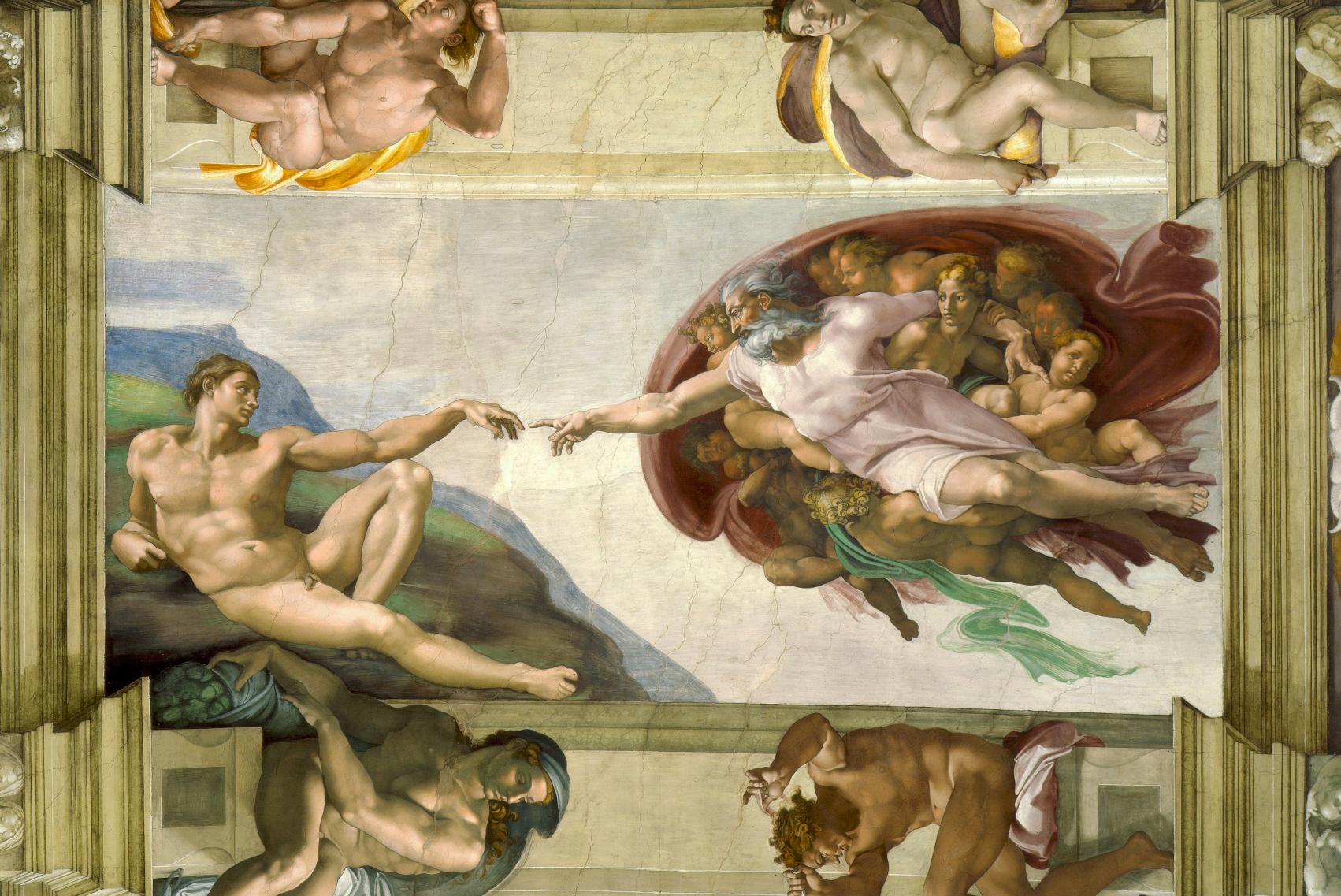 The Creation of Adam shows with extraordinary power and subtlety the moment
when the hand of God gave life to Adam, and symbolically to the human world.
The Creator’s flowing mantle encloses some eleven figures, angels or beings
that existed before man, and they support him as he stretches out his arm to
touch the finger of Adam. Reclining in a superbly graceful attitude, Adam’s
perfect, muscular body reveals his latent strength. The hands just touching
provide an emotional tension as well as a physical link between God and man.
The magnificent sculptural figures, dominating the spaces around them, express
in Michelangelo’s vast and dramatic conception the full significance of the
moment of creation.
The Creation of Adam shows with extraordinary power and subtlety the moment
when the hand of God gave life to Adam, and symbolically to the human world.
The Creator’s flowing mantle encloses some eleven figures, angels or beings
that existed before man, and they support him as he stretches out his arm to
touch the finger of Adam. Reclining in a superbly graceful attitude, Adam’s
perfect, muscular body reveals his latent strength. The hands just touching
provide an emotional tension as well as a physical link between God and man.
The magnificent sculptural figures, dominating the spaces around them, express
in Michelangelo’s vast and dramatic conception the full significance of the
moment of creation.
At its unveiling the ceiling of the Sistine Chapel was hailed as a supreme work of art, and it earned its artist the name Il divino Michelangelo.

